Affiliate links on Android Authority may earn us a commission. Learn more.
Why the Apple vs Samsung $1 billion verdict is correct and should stand
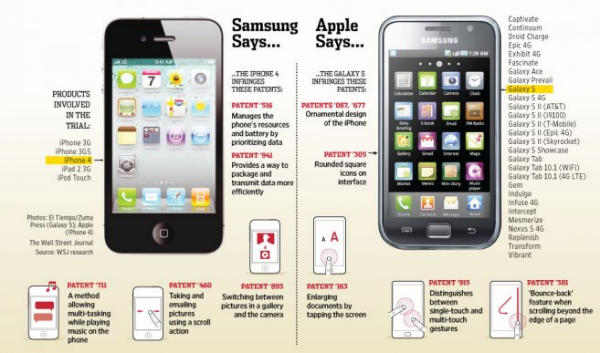
The first U.S. Apple vs Samsung battle has ended in late August, with a surprisingly bitter defeat for the South Korean Android maker – surprising not because Samsung was found to infringe on certain Apple patents, but because of the nature of the total Samsung defeat.
Samsung was found to willfully infringe on 6 from its 7 patent claims Apple brought to this battle against its rival and was awarded $1.05 billion in compensatory damages. Meanwhile, the jury found Apple not to infringe any of Samsung’s patents, including the FRAND, or standards essential, ones.
Sure, the fight is not yet over as the two companies are still duking it out in over 50 cases spread across 4 continents, and there are plenty more battles to be fought until we find a real winner, including at least one more U.S. case – although we’re probably see the two giants settle sooner or later even though that’s not an option right now. And sure, Samsung will appeal this particular decision, while Apple will try to obtain injunctions against various Samsung-based products in the region in the coming months.
But ultimately, the verdict is correct and should stand, in my opinion, and no matter how hardcore an Android fanboy you are or how much you hate Apple for whatever reason, you can’t disregard the fact that Samsung brought this shit storm on to itself by blatantly copying Apple’s devices. And I’ll tell you why in a series of posts based on the Apple vs Samsung lawsuit and all the chatter that followed – yes, this is only the beginning.
A rectangle with round edges
Apple is not selling just a black rectangle with round edges, an unpattentable form factor as so many people seem to believe, and neither is Samsung. If they did, then those devices would look like this:
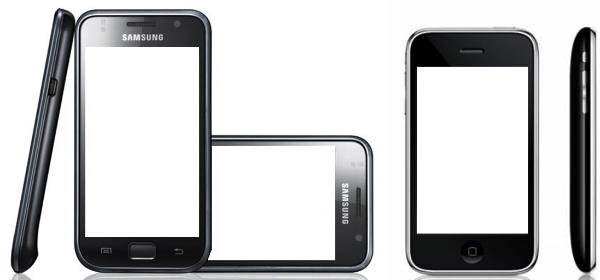
And it doesn’t market a device that has a grid of icons that have round corners and a fixed menu at the bottom of the home screen, and neither does Samsung. If they did, we would have something like this:
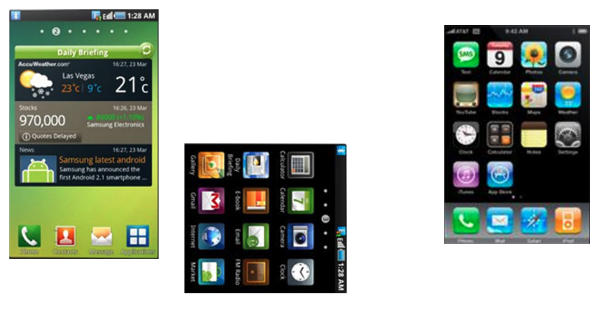
If any of the two hypothetical scenarios above were true, then Apple would not have accused Samsung of blatantly copying the design of the iPhone and iPad. But the two companies are selling a variation of these two devices:
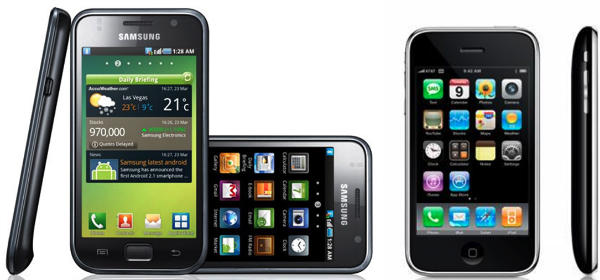
Apple sells a black rectangle device that has round edges, a home button, and a recognizable screen that features a grid of apps and an apps dock that stays the same no matter what homescreen you’re in. But that device is protected by a flurry of patents that each describe various functionalities, as a patent can be awarded for everything that’s inside a device like a phone. Together, those functions and design elements make an iPhone. And most of them are protected by patents.
And some of those features and design elements were chosen by Samsung to also make a Galaxy-branded device. No matter how lawyers would break each patent down and try to prove it shouldn’t have been awarded in the first place, the patents combined are meant to defend a device that, when launched, could make or break the company that unveiled it. That’s even if when looking at one patent at a time without viewing the bigger picture, you start to question its claims and validity.
As it turns out, the iPhone became the best Apple product yet and didn’t break the company, which convinced rivals that’s the way to go when it comes to designing smartphones.
It’s an iconic design that makes the iPhone and iPad highly recognizable in stores. And that’s the sort of design that Samsung decided to imitate with its first high-end device that caught the eye of the Android consumer, the Galaxy S, announced at CTIA in March 2010 and launched in several markets in the months that followed.
That design ensured some confusion among users, and don’t tell me that you’ve never heard inexperienced, tech-unsavvy buyers say that the Galaxy S looks like an iPhone, at least from the distance, or when looking at Galaxy S official pictures. If that happened at least once, than Samsung’s job was done, even if some customers quickly realized the differences between the two devices. Samsung created a device that looked like an iPhone and hence was as usable as an iPhone in people’s minds.
Sure, experienced consumers will never confuse the two because they have all the background information they need not to make that mistake. But unfortunately for Samsung, the majority of consumers are not as tech-savvy. And since the iPhone quickly became fashionable among smartphone buyers because of the new features it brought to the table, or because it looked cool – that wouldn’t have happened with a mediocre product – it’s easy to understand how plenty of customers decided to jump on the smartphone bandwagon without necessarily needing a smartphone. Or without knowing what the differences between an iPhone 3GS and a Galaxy S were at the time the latter was launched. In fact, choosing either model in 2010 would have offered you a great smartphone experience, no matter who your mobile allegiance laid with, and let’s remember that those were still the early days of this smartphone revolution.
And sure, Samsung understood the dangerous waters it entered with the device as it started to diversify its upcoming Galaxy-branded devices in the following years in order to avoid clashes with Apple. But the Galaxy S established a bridgehead for the company, which used the iPhone momentum combine with the recent rise of Google’s Android OS to fortune to get a strong foothold in the smartphone marketshare. The Galaxy brand became cool by association if you will, a strategy that helped Samsung rise on top of the business.
No longer was Samsung trying to dethrone Nokia from the number one position in the cell phone market, but the company was fighting against the Apple, the newest comer to the mobile wars, realizing the danger the iPhone maker poses to the future of the smartphone market.
Capturing mind and market share
While Samsung did start to make modifications to its Android devices to avoid clashes with Apple, the damages was already done by the original Galaxy S and its following variations. And from time to time a device like the Galaxy Ace 2 / Ace Plus (an early 2012 device) would pop out reminding people why Apple is suing Samsung. The Galaxy Ace 2 was launched to compete against the iPhone 3GS this year, a device that has been around for more than three years and which was discounted down to $0 with new two-year contracts in the USA once the new iPhone 4S was introduced in October 2011 – it’s not like Samsung didn’t have enough low- to mid-range products to chew away at Apple’s marketshare, but it just had to launch an iPhone look alike in the midst of its legal conflicts with Apple, didn’t it? Of course, by this time even regular smartphone buyers would know the difference between a Samsung product and an Apple corresponding competitor – so there’s no danger of confusing the two anymore, is it?
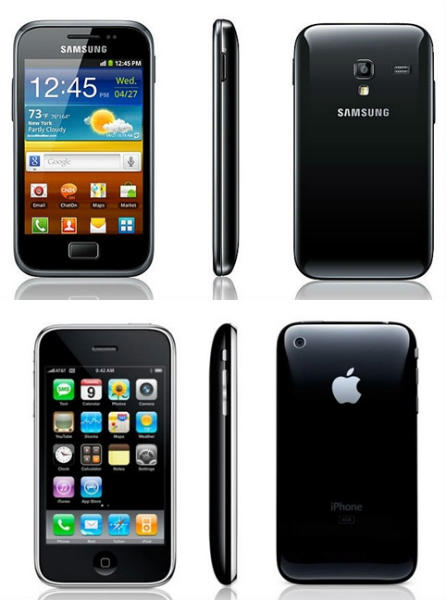
But would that really matter if the mind of the consumer was already manipulated by devices like the Galaxy S and its successors to believe that Samsung can make smartphones just as good as the iPhone but more affordable – and I’m not saying those devices aren’t or weren’t great choices at their time, or that believing they were highly competitive choices was a mistake.
Just think about the Android ecosystem for a second. Because it’s so volatile in terms of new launches, low- to high-end devices can’t keep their initial price points for more than a few months before carriers and third-party electronics retailers offer discounts. The “older” the device is, the higher the discount. That doesn’t happen in the Apple world, where Apple only discounts its products once a year, during the new iPhone launch, when the older-generation devices receive price cuts. And because the subsidy isn’t cheap, the vast majority of carrier partners prefer not to mess with the price either, to avoid losing any cash with such practices.
So the consumer who started seeing in Samsung a worthy smartphone maker that owns its own highly recognizable brand knows that the Galaxy Insert Name product will be cheaper in one or two months (subsidized version) than its iPhone counterpart that will only get discounted when the next iPhone is released. So then why not buy a Galaxy-branded smartphone instead?
How do you think Apple felt about that?
Galaxy, the most powerful Android brand
Besides realizing that it’s the iPhone that it has to beat, Samsung also saw what other players in the Android world failed to see, the need of a strong brand. The Galaxy S was the first device in its family, and then more and more smartphones and tablets got the Galaxy particle in their name.
Meanwhile, other Android device makers failed to understand the importance of a strong brand, or adapted only later to that need.
Why is branding important? Well, because we always refer to Apple smartphones as iPhone Insert Version not Apple iPhone Insert Version whereas one of the latest Android handsets is called the Motorola Droid RAZR Maxx HD. You know who makes the iPhone and what OS it’s running. But if I were to list HTC’s, LG’s or Motorola’s 2010 Android-based devices, without mentioning the maker, would you know who made them at the time – assuming of course you haven’t covered the mobile environment as thoroughly as I did in the recent years?
It took HTC, Motorola and LG a while to come out with their One, RAZR and Optimus brands, respectively, but they may be too late to the naming game. Samsung has slowly amassed more and more customers and won marketshare thanks to its Galaxy brand, while HTC, Motorola and LG lost buyers. Are Samsung devices superior to the Android competition’s offerings, considering that same-year handsets are sporting almost the same components and same OS version? No, but Samsung managed to ride the iPhone-like-device momentum and build mindshare way ahead of everyone else.
The Galaxy S3, also the scope of a different Apple trial, is rumored to be a lawyered device. It doesn’t look anything like an iPhone, not even from the distance. The same things applies to the Galaxy Note 2 monster. But its popularity among Android users would not have reached current heights among consumers without devices like the Galaxy S and its successors.
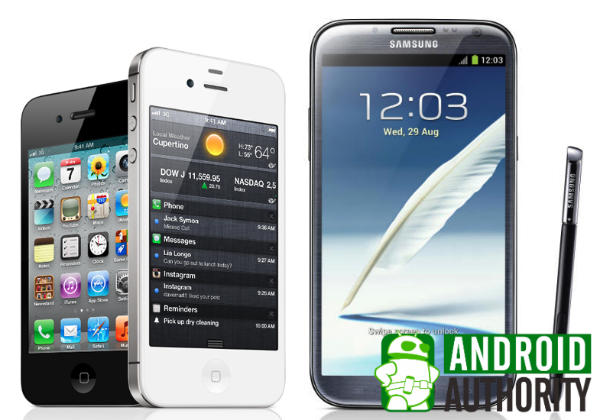
Just look at the HTCOne X, a high-end device that’s the most important Galaxy S3 rival out there, but which isn’t selling Galaxy S3 like. Maybe because HTCdid not copy the iPhone’s design and appearance. Or else Apple would have sued for that too.
And that’s how Samsung rose from quarter to quarter to become the leader in the smartphone market, passing by all other Android device makers in the process, but also Apple, currently in second spot. Not to mention moving past its former mortal enemies, Nokia and RIM, that are trying their best to stay relevant in a post-iPhone smartphone universe.
You may have noticed that I mostly referred to Samsung smartphones and disregarded Samsung tablets so far. That’s because Samsung’s rise started with smartphones, not with tablets. In the tablet market however, even if Samsung has found not to be infringing on Apple’s iPad design, there’s no real need from Apple to push Samsung tablets out of stores, because, let’s face it, Samsung isn’t selling as many units as it would want to. There are other devices that will do that for them, without hurting iPad sales in the process. They are called the Kindle Fire and especially the Google Nexus 7, which are exactly what Apple needs in the Android tablet ecosystem, a fight that can’t be won by regular Android tablet makers competing against budget devices coming from huge content providers like Amazon and Google.
Hindsight is always 20/20
Apple haters will have to remember that without the iPhone, the smartphone may have been be dominated by Symbian, BlackBerry OS and Windows Mobile 6.x for years to come. These “old” mobile OSes look dull in hindsight, but how many of you were checking such smartphones out, or using one when you-know-who arrived. Sure, Android would be in that list somewhere, but would Android have become as popular as it is today, and as fast as it happened with a BlackBerry-like QWERTY keyboard-based non-touchscreen design as it did thanks to the help of a touchscren interface and a rich app ecosystem?
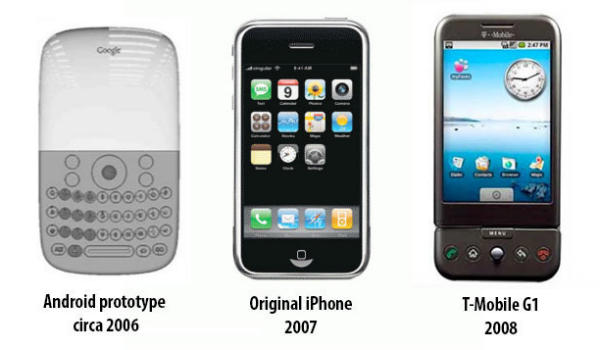
So if it was Apple that reshaped the industry, by hating the iPhone maker and saying it didn’t invent anything new and it doesn’t deserve to sue the competition to protect its non-inventions, one would be partly hating Android too, one of the byproducts – no matter if better or worse – of iOS, or iPhone OS as it was called initially.
That’s what Apple created with the iPhone. It brought a heavily contested design to market and it risked its own money and lots of R&D to create the device and an as-smooth-as-possible user experience. But competitors were not convinced such a device would succeed, and they only came out with Android- and/or touchscren-based devices later in the game when it was clear that Apple was not going to take any prisoners, and that users liked the new thing.
And then Apple was also first to bring out a mobile content store that took off and was immediately followed by Google and others.
Five years later it all looks “obvious,” because the smart mobile devices you have today are all basically similar: they have a rectangle shape with rounded corners and a plethora of apps spread around various home screens in a grid-like manner. But not all of them are “blatantly” copying the iPhone and iPad.
And Apple did not just attack the most popular Android maker out there, as you would believe now. That’s also a hindsight-based statement to make. It attacked them all, at the moment it thought their products to be infringing its own patents. And when it did file suits against Samsung, HTCand Motorola, the first was not the leader of the smartphone univers, the second was not in the world of hurt if finds itself today and the third was not just a patent collection hastily purchased by Google for an exorbitant price.
They were all, at least according to Apple, infringing on its patents. But just one was accused of blatantly copying the iPhone and then the iPad design, while every other suit is about software patents. Is it just a coincidence that the smartphone maker that had the most iPhone-like design, at least in Apple’s view also became the best-selling Android maker out there?
Software patents be damned
Plenty of people believe the U.S. patent system is unjust and that software patents should not be easily awarded for such “obvious” things like some of the features found on Apple’s devices. Sure, there’s only a way to arrange icons on a grid, multitouch is “obvious” and so is “tap-to-zoom.” Although there are plenty of ways not to choose a sunflower as your Photo app icon.
But if they’re so obvious and natural, and if they should be standards – who knows, probably they will be standards in the future, which is certainly how Google would like it – why weren’t they “invented” by Samsung, or Google, or anyone else before the iPhone was launched?
And do you think that had Samsung invented tap-to-zoom or whatever must-have smartphone features you take for granted today, it wouldn’t have been patented? It would have been, and Samsung would have waited around the corner to defend those software patents.
If that’s not enough then how do you explain the fact that almost every Android maker out there has settled with Microsoft, and it’s paying the company royalties for every sold Android device – in fact Microsoft is making more money than Google from actual Android sales, and I’m not including here the ad revenue generated by Android devices? Why didn’t they settle with Apple? Why didn’t they seek a license to use Apple-developed tech?
You know who did do that? Microsoft. The Redmond-based company will launch its own tablet later this year, the Surface, and it looks like Microsoft already has a deal in place with Apple to avoid any future legal proceedings. According to it, Microsoft has to come out with different designs for its devices.
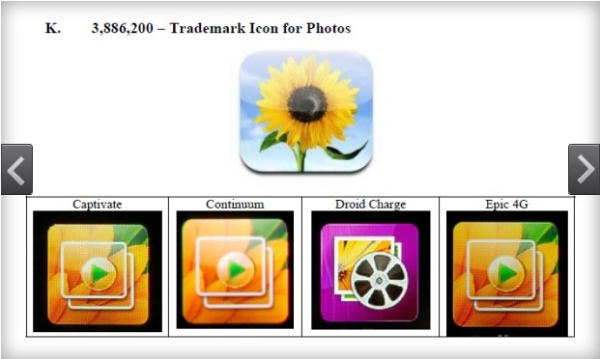
What about prior art, or prior devices that use Apple-like tech that was developed before Apple was granted the software patents it asserts against Android device makers. Why aren’t there any popular gadgets out there pre-dating the iPhone and using the technology that Apple patented erroneously according to some? Because their makers did not pursue these projects and/or were not able to go to market with devices using technologies as found in current smartphones.
And in case you’re annoyed at Apple for over-patenting its devices you’ll have to remember that Apple already went through this sort of thing in the early days of the Macintosh vs Windows computers. It just didn’t want any mobile OS, and probably Windows Mobile was perceived as the most important threat to iOS and iPhone when the original iPhone was launched, to do to its smartphone line what Windows computers did to its Mac line. That’s why Apple filed a patent for every little thing it considered important for the iPhone and iPad experience, without knowing beforehand whether the patent will be awarded or not. It tried to protect its intellectual property, and when the patent was granted it tried to further defend it even if that meant going to court.
Can you blame Apple for doing it? Yes, you can, in hindsight, because you’ll say the company is greedy, wants to turn a profit, doesn’t pay enough taxes, wants to stop competition in the courts, and what not. But did you feel the same about the company before you became an Android fan or before the iPhone was launched? Are you actually blaming Apple for employing certain marketing tactics like generating buzz around overpriced devices to make money? Are you blaming it for its needs to defend the way it’s making money? Aren’t Apple device buyers getting good-quality even if not perfect devices in return for the price they’re willing to pay for the Apple device they choose to buy?
Shouldn’t Samsung be equally punished, morally speaking, for making money at all costs off of its consumers? Just look at this Galaxy Note 10.1 review which reveals how a flagship device is basically an overpriced, sucky device that’s nowhere near the high-end side of the spectrum and which shouldn’t be sold for a high-end price?
Why stop there? Why not go after Google and its privacy-infringing tactics all in the name of better ads and more ad-based revenue – yes, Google, if you did infringe on anyone’s privacy more than once, you can’t call it just an accident anymore. As one famous president hastily said: “Fool me once, shame on – shame on you. Fool me … you can’t get fooled again.” But that’s a different story, for a different day.
And then, there’s the evidence
I have thoroughly covered the Apple vs Samsung trial and I said a bunch of times that Samsung has the work cut out for itself in court where Apple has presented plenty of evidence that questions Samusng’s intentions when creating its own Android handsets and tablets. We’ve seen the 132-page internal report that was making recommendations to Samsung design and engineer crews to adapt the I9000 prototype (the Galaxy S) to better mimic iPhone functionality, we’ve seen the internal “crisis of design” memo, and we’ve seen the Google warnings to Samsung that certain Galaxy branded devices including tablets looked too much like an iOS product.
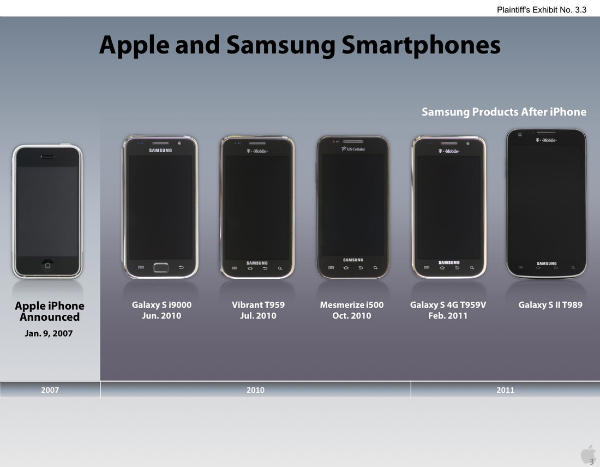
Meanwhile, Samsung was not able to convince the jury that Apple was infringing on standards essential patents, and frankly I don’t think it had a chance to win anything with these kind of patents – in fact Samsung and Motorola are both investigated for FRAND patent abuse in their court conflicts with Apple, with the former being under scrutiny both in Europe but also in its home country, South Korea.
The verdict is not a surprise considering that between the two it’s Apple that has won the most favorable rulings in most courts to date, including the U.S., with Samsung having a hard time obtaining any positive results against the iPhone maker.
No matter what outcome, the real winners are the consumers
We keep hearing that because Samsung has to pay $1.05 billion to Apple in damages (that may still change in the future, and if it doesn’t, there’s always the pay-by-nickels option), competition is being stifled. That’s hardly the case. Such verdicts, even Samsung’s copying of Apple’s iPhone, are all in our favor as they will further drive innovation.
In fact, we already have proof of innovation happening as the result of several patent infringing events. First, Samsung copied the iPhone with the Galaxy S which showed Apple that companies were ready to catch up to Apple. That meant that Apple had to intensify its efforts and include more and more features in its upcoming devices to stay relevant in a market that was advancing rapidly. And Apple, which has used its client base to expect major improvements every two years or so, may have been compeled to come out with better features in new products than it would have wanted. Maybe Apple’s initial strategy was to come out with mild updates year after year, but was forced to be more aggressive because of the increasing competition from Android. We’ll never really know. What matters is that Apple had, and still has to keep working hard to still bring out devices that will sell like hot cakes. That’s certainly in our favor.
Whether the verdict is final and Samsung ends up paying Apple the damages as awarded by the jury, or the two companies settle, it doesn’t mean Samsung products will die or that Samsung will lose significant market share. Not at all! In fact, Samsung’s recent products are not exactly iPhone- and/or iPad-like. Just look at the Galaxy S3 and the Galaxy Note 2. Like Apple, Samsung has the money to invest heavily in its R&D department to come up with better mobile devices in the future. Unlike its Android competitors, it can afford to invest a lot more in R&D, not to mention it can further develop Bada in response to the verdict, but also in the face of increasing competition from Google devices like the Nexus 7 and the latest Motorola devices.
In fact, being the number one smartphone maker in the world will bring even more cash to the company, so $1 billion isn’t that much to pay to admit it copied the iPhone. Because Samsung is in no danger of losing sales and market share anytime soon, no matter what the verdict is. It has too many Android devices that appeal to various target buyers to risk becoming irrelevant in the mobile space. It doesn’t even have to admit, ever, that it copied the iPhone even if the jury said so. Because, again, $1 billion is pocket change compared to what Samsung has in its coffers.
As for devices that could get banned in the U.S. or other regions? By the time a final decision is taken on Apple’s ban requests, those devices will no longer be relevant for that market, meaning that Samsung has already sold as many units it could have sold in the U.S. before buyers were wooed by other Android devices, made by Samsung or any other OEMs.
And let’s not forget about other mobile operating systems out there, namely Windows Phone 7 and BlackBerry OS. This sort of legal victories should further motivate companies like Microsoft, Nokia and RIM to work hard at coming back into the game to try to take advantage, if possible, of any temporary Apple-friendly court rulings. We don’t want a mobile ecosystem that has just two options, iOS and Android, we want as many players as possible. as that would really encourage competition. That too is certainly in our favor.
The verdict is correct and should stand
I think I have thoroughly explained why the verdict is correct and should stand. Whether you like or hate Apple and/or Samsung, you should really check out the background and the facts that lead to the verdict in the first place. What you shouldn’t do is feel sorry or happy for either party involved in the trial. These are giant corporations that know what the risks are when playing the game, that can take care of them selves and that can take a $1 billion hit while still coming out on top. Ultimately, it’s the law of the jungle, the survival of the fittest.
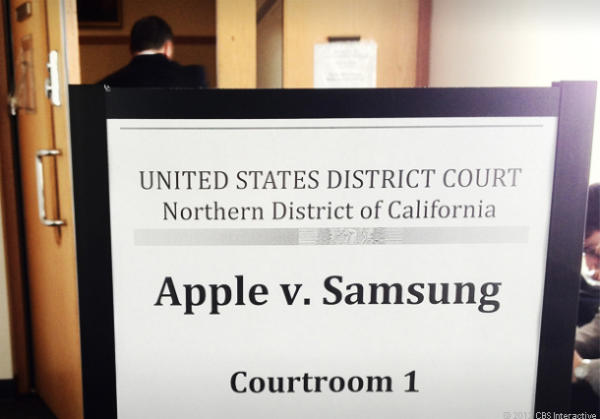
There’s no stifling of competition and there’s no good guy. It’s just another day in the mobile business, and the more details you know about it the better you can accept the verdict and move on.
At the end of the day the fact remains you like the mobile device you currently hold in your hands – maybe you’re reading these lines on one. No matter what OS it runs and who made it, chances are it’s a square with somewhat rounded corners and a bunch of icons on a touchscreen display. It may or may not look a lot like an iPhone.
But… it exists because back in 2007 Apple launched the iPhone and then Google caught up to iOS with Android. Then each party tried to beat the other, involving plenty of players along the way. Fast forward to today and you’re holding that device in your hands. Would it be as appreciated if the iPhone wouldn’t have been made? If Android wouldn’t have been open-sourced? If the Motorola Droid and Verizon would not have helped put Android on the map? If Samsung would not have copied the iPhone and prove that Android is a competitive OS? You get the idea, don’t you?
With that in mind, join us in the following parts of this story, as we’re going to look further more at this Apple vs Samsung conflict and why the verdict is correct. And yes, I know this is an Android blog.
Next up, we’re going to show you a brief history of the early days of the iPhone and the first Android handsets.